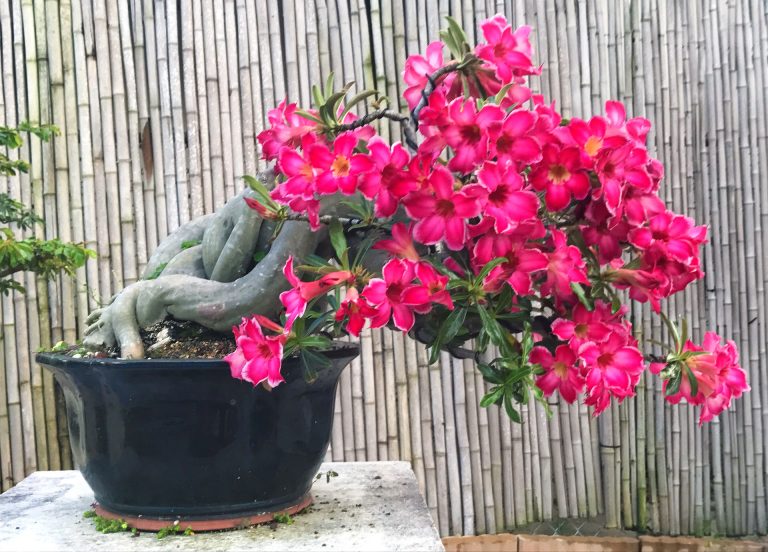
The Desert Rose
Adenium obesum is also known by the names Sabi Star, Kudu, Mock Azalea, Impala Lily and most notably the Desert Rose. It is a long-lived plant and in the right conditions it can live for centuries, five hundred years is not uncommon.
It is native to Africa, the Middle East, Madagascar , Southeast Asia, and Thailand. It is not a rose. It is a drought-deciduous succulent shrub. Adeniums, as they are commonly known, are actually more related to Alamandas, Oleanders and Frangipanis. Being a sub species of the Dogbane family it is highly toxic. The milk sap in the roots and stems of the Desert Rose is poisonous. If ingested and the toxin reaches the heart, it can cause heart failure and, in severe cases, death in humans and animals . But oddly enough, all the parts of the desert rose have a medicinal value and are used in traditional medicine in many countries. Medicinal applications include headache, joint and muscle pains, various skin diseases, treating septic wounds, tooth decay and on livestock to kill parasites. Research is ongoing to identify if it can cure some types of cancers.
The Desert Rose develops a caudex, or swollen trunk with pachycaul stems. The leaves are spirally arranged, clustered toward the tips of the shoots and leathery in texture. The flowers are tubular,with five petals, resembling those of other related genera such as Plumeria. The flowers tend to be in shades of red and pink.
INTERESTING FACT: To identify the age of a desert rose growing in it’s natural habitat, measure the diameter of the stem. This is a slow-growing plant and every millimeter represents one year.
PLACEMENT: Adenium plants are native to regions with poor, gritty soil and hot, sunny climates. Direct sunlight is preferable, especially when they are in their active growth phase during the summer months. Some protection from noon day super hot sun is good as this can scorch the foliage. During winter time they will go dormant and usually drop their leaves They are also NOT frost tolerant and will not survive long if exposed to temperatures below 40/50 degrees
WATERING: The one thing that will kill these plants quickly is improper watering. They do not tolerate soggy soil and will get root rot if roots are kept real soggy. They thrive on a similiar watering regime as cacti, but, in our well-drained soil and in hot summer sun, daily watering may be needed. All succulent plants have some sort of water storage system, be it leaves, stems, or roots. In the Desert Rose the trunk or caudex swells to conserve moisture for times of drought. A nice fat trunk is an indicator of plant health. A skinny trunk or stems can indicate that the plant requires more moisture. In the fall and winter months, when temperatures drop to 50/55 degrees, (this is when the tree typically goes dormant in the wild), drastically reduce moisture, watering only minimally once a month or even not at all. Remember, a swollen, thick trunk (in proportion to the size of your plant) is a great indication that your tree is well-hydrated. If your adenium is under lights in your tropical wintering quarters water when needed. It may even bloom for you.
FERTILIZING: Adeniums will benefit from a dilution by half 20-20-20 fertilizer with trace nutrients, starting in April. when the plant is actively growing You can switch to a higher level phosphate when flowering begins. Do not feed the adenium during winter dormancy.
PRUNING: You can prune the adenium bonsai year-round but the hottest time of the year is best. Remove cold-damaged growth as soon as new growth emerges. Trim long, lanky stems to balance the stem growth symmetrically. Remove branches that rub or cross other branches, cutting just above a leaf node or where the stem joins with another stem. Adeniums develop more flower buds after pruning since the buds develop on new growth. It is recommended to WEAR GLOVES as the sap is toxic.
WIRING: It is very important to totally stop watering the adeniums at least 10 days to 2 weeks before doing wiring. This makes the branches more pliable and less prone to breakage. When you wire the branches, do not wire them too tightly or the wire will cut into the growing branches and leave ugly wire marks.
REPOTTING: Again, wear gloves as the sap is toxic. (another good use for all those leftover covid blue latex gloves) Repotting is most successfully done in the hottest time of the year from June to August. Your Desert Rose should be repotted every two to three years or when you see that the roots are completely filling the pot. When repotting a succulent, make sure the soil is completely dry before gently removing the plant from the pot.The leaves will begin to turn yellow due to a lack of water and will fall off but it is OK. Use a chop stick or water spray to loosen the plant from the pot to ensure the roots are not harmed.( Jerome Kellerhals has a very good YouTube clip on this ). Knock away old soil from the roots and remove any rotted or dead roots in the process. If you make any cuts or notice bruises, the tree should be allowed to dry with its roots exposed and in the shade for a week or so to allow the fresh cut roots to dry up thus hopefully avoiding root diseases or rot OR you can topically apply a fungicide or antibacterial solution. Each time you re-pot, the plant should sit a bit higher. This encourages the roots down further and the cortex to sit above the surface of the soil and fill out more. Raise the woody base of the plant (the caudex) between 1-4 inches depending upon the size of your tree. Branching roots can be draped over a small rock for added support and attractiveness. After repotting let the plant soil dry for a week or so to reduce the shock then begin watering the plant making sure water drains thoroughly. Do not let the plant sit in standing water or soggy soil. Put your tree back out in full sun after another week or so. When repotting an adenium, you can defoliate, trim, and wire all at the same time.
PESTS AND DISEASES: Desert rose is a relatively disease and pest-free plant. The most common pests are scale, mealybugs, with Spider mites being the greatest challenge The biggest problem affecting this plant is overwatering.
PROPAGATION: An Adenium can be propagated by seed or stem cuttings. While plants grown from seed are more likely to have the swollen caudex at a young age, with time many cutting-grown plants cannot be distinguished from seedlings. If propigating from a cutting, allow the cutting to dry out for a day or two before continuing. If propigating from seeds the best time to sow desert rose seeds is in the spring.
Written by Charlotte Field
References: Marcel Iseli, Bonsai Empire, Caring for Your Desert Rose Plants by Bonnie Grant, How to Grow and Care for Desert Rose by Jon Vanzile, Adrienne Legault, Gardening Australia, bageecha, Jerome Kellerhals and Sony Le




